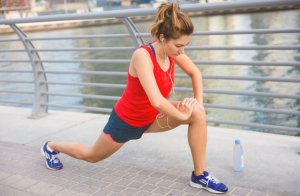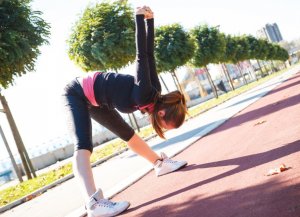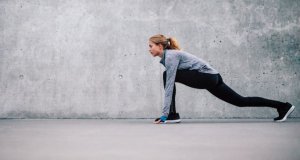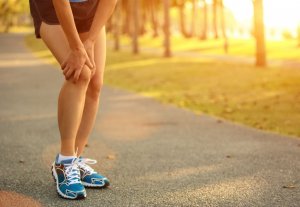The Best Time to Stretch

In sports and physical disciplines, we stretch when our bodies are still warm from exercise. Stretches consist of exercises to lengthen and mobilize the muscles, joints, and ligaments. Likewise, stretching involves placing the body in positions, in which the muscle is stretched beyond the length it may have been when resting.
By constantly stretching the muscles, they gradually gain flexibility. Stretching is necessary to improve the body’s performance in any physical activity. There are disciplines in which it’s strictly necessary to have good flexibility, as is the case in ballet, gymnastics or synchronized swimming.
If you have decided to improve your flexibility, this article is for you. Keep reading to discover the best time to take advantage of stretches!

Warming-up or stretching
Stretching isn’t the same as warming-up. Warming-up in sports is when the body is preparing for the next physical activity. That is, a series of exercises need to be performed, including a few stretches, to condition the body for training. If you only stretch the body, you will feel that you are still at rest, therefore, warming-up isn’t just synonymous with stretching.
Stretching is considered a physical activity with the objective of elongating the muscles to achieve their lengthening. In this way, stretching is a physical activity that also requires a previous warm-up.
When is the best time to stretch?
Many people think that the best time to stretch is before training, but it’s not. Actually, the best time to stretch is after physical activity, since the effectiveness is much higher. Especially if you have completed a high impact physical activity.

Reasons you should stretch after working out:
- The muscles need to be relaxed: after a session where the muscles are exposed to all types of contractions, they need to be relaxed and oxygenated.
- The body is apt to stretch better: after training the body is at its maximum expression, that is, there is a good blood flow, a good heart rate and the muscles are awake. Therefore, it makes the body more prone to stretching.
- There is no risk of muscle strain: if you perform certain stretches without the body being warm, you run the risk of muscle strain. Also, stretching after training reduces the risk of this happening, since the body is warm enough to stretch.
Everything is progressive
Stretching after training is certainly effective in making muscles more flexible. In addition, it improves posture, refreshes muscles and helps the body to rest. As with any physical activity, you acquire strength, speed and resistance with practice and perseverance. The same thing happens with flexibility, that is, it’s not something that you can easily achieve in just a week.
To be flexible, you must have patience and perform the stretches correctly. This means, not forcing yourself to adopt positions that are extremely painful. Stretching means lengthening the muscle, so this can generate a little tension and you should relax and breathe. And at the same time never force a stretch, as this could cause injuries or trauma.

Stretching after exercising is really important for self care. Muscles, ligaments and joints need to rest after an intense session. The best thing is for the muscles to relax little-by-little through stretching.
If you don’t know much about stretching you can click here and see some stretches that you can include in your exercise routine. Remember to wear appropriate clothing and stretch on a comfortable surface. Also, be patient. Stretching is something that you should enjoy as the body begins to rest. So get ready to stretch after a good workout!
In sports and physical disciplines, we stretch when our bodies are still warm from exercise. Stretches consist of exercises to lengthen and mobilize the muscles, joints, and ligaments. Likewise, stretching involves placing the body in positions, in which the muscle is stretched beyond the length it may have been when resting.
By constantly stretching the muscles, they gradually gain flexibility. Stretching is necessary to improve the body’s performance in any physical activity. There are disciplines in which it’s strictly necessary to have good flexibility, as is the case in ballet, gymnastics or synchronized swimming.
If you have decided to improve your flexibility, this article is for you. Keep reading to discover the best time to take advantage of stretches!

Warming-up or stretching
Stretching isn’t the same as warming-up. Warming-up in sports is when the body is preparing for the next physical activity. That is, a series of exercises need to be performed, including a few stretches, to condition the body for training. If you only stretch the body, you will feel that you are still at rest, therefore, warming-up isn’t just synonymous with stretching.
Stretching is considered a physical activity with the objective of elongating the muscles to achieve their lengthening. In this way, stretching is a physical activity that also requires a previous warm-up.
When is the best time to stretch?
Many people think that the best time to stretch is before training, but it’s not. Actually, the best time to stretch is after physical activity, since the effectiveness is much higher. Especially if you have completed a high impact physical activity.

Reasons you should stretch after working out:
- The muscles need to be relaxed: after a session where the muscles are exposed to all types of contractions, they need to be relaxed and oxygenated.
- The body is apt to stretch better: after training the body is at its maximum expression, that is, there is a good blood flow, a good heart rate and the muscles are awake. Therefore, it makes the body more prone to stretching.
- There is no risk of muscle strain: if you perform certain stretches without the body being warm, you run the risk of muscle strain. Also, stretching after training reduces the risk of this happening, since the body is warm enough to stretch.
Everything is progressive
Stretching after training is certainly effective in making muscles more flexible. In addition, it improves posture, refreshes muscles and helps the body to rest. As with any physical activity, you acquire strength, speed and resistance with practice and perseverance. The same thing happens with flexibility, that is, it’s not something that you can easily achieve in just a week.
To be flexible, you must have patience and perform the stretches correctly. This means, not forcing yourself to adopt positions that are extremely painful. Stretching means lengthening the muscle, so this can generate a little tension and you should relax and breathe. And at the same time never force a stretch, as this could cause injuries or trauma.

Stretching after exercising is really important for self care. Muscles, ligaments and joints need to rest after an intense session. The best thing is for the muscles to relax little-by-little through stretching.
If you don’t know much about stretching you can click here and see some stretches that you can include in your exercise routine. Remember to wear appropriate clothing and stretch on a comfortable surface. Also, be patient. Stretching is something that you should enjoy as the body begins to rest. So get ready to stretch after a good workout!
All cited sources were thoroughly reviewed by our team to ensure their quality, reliability, currency, and validity. The bibliography of this article was considered reliable and of academic or scientific accuracy.
- Alter M (2004). Los estiramientos. Consideraciones generales acerca de la flexibilidad. Editorial Paidotribo, capítulo 1.
- Ayala F, Sainz P, Cejudo A. (2012). El entrenamiento de la flexibilidad: técnicas de estiramiento. Revista Andaluza de Medicina del Deporta, (5)3. Disponible en: https://www.sciencedirect.com/science/article/pii/S1888754612700163
- Calle P, Muñoz M, Catalán D, et al (2006). Los efectos de los estiramientos musculares: ¿qué sabemos realmente? Kinesiología 9(1). Disponible en: https://www.sciencedirect.com/science/article/abs/pii/S1138604506731136
This text is provided for informational purposes only and does not replace consultation with a professional. If in doubt, consult your specialist.








